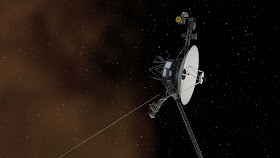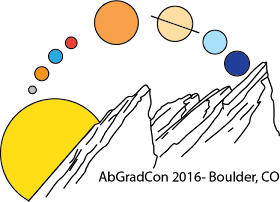Sadly, for me, now comes the time when I have to crunch the numbers, compile receipts, and submit financial reports for everything from the conference. Definitely not looking forward to it, but it has to be done, so here's some of what I'm listening to as I run the numbers today: Gimme Shelter from The Rolling Stones!
I am an astrobiologist, sci-fi geek, and professor of everything groovy. I write about science, culture, math, history, space, and science fiction. Perhaps like you, I'm seeking a greater understanding of the nature of life and asking myself why all of this really matters. Come with me, and we'll ask some questions together.
Friday, July 29, 2016
Gimme Some Shelter from All of This Accounting!
AbGradCon 2016 was a success! The conference was a lot of fun and we heard about lots of great science that graduate students and early career scientists in various disciplines of astrobiology are conducting. We also had some really fun events that went along with the conference.
Sadly, for me, now comes the time when I have to crunch the numbers, compile receipts, and submit financial reports for everything from the conference. Definitely not looking forward to it, but it has to be done, so here's some of what I'm listening to as I run the numbers today: Gimme Shelter from The Rolling Stones!
Sadly, for me, now comes the time when I have to crunch the numbers, compile receipts, and submit financial reports for everything from the conference. Definitely not looking forward to it, but it has to be done, so here's some of what I'm listening to as I run the numbers today: Gimme Shelter from The Rolling Stones!
Wednesday, July 20, 2016
FAN-O-RAMA looks like it's going to be all kinds of fun
Some people are putting together a live action fan film for Futurama, and it looks awesome! Here's the teaser trailer:
Find out more at their website: fan-o-rama.com
Find out more at their website: fan-o-rama.com
Monday, July 18, 2016
AbGradCon 2016
This cosmobiologist won't be writing a lot here in the coming week. I'm one of the organizers for the 2016 Astrobiology Graduate Conference (AbGradCon), to be held at the University of Colorado Boulder. This conference is going to be lots of fun. I'll review everything once (if?) I survive all of the logistics of bringing this thing together.
Friday, July 15, 2016
Crabby, Crab, Crabby, Crab, Crab.
There's a neutron star in the middle of the Crab Nebula, and that sucker is spinning 30 times every second!
 |
| Image Credit: NASA, ESA, J. Hester (ASU), and M. Weisskopf (NASA / MSFC) |
The image of the Crab Nebula above comes from a composite of x-ray and optical light data from the Chandra X-ray Observatory and the Hubble Space Telescope. The video below shows the two different types of image (x-ray in blue, optical in red) in seven different sets of images from November 200 to April 2001. Those images have been looped many times to create a video, where you can see the swirling stellar winds moving through the nebula from the pulsar.
The Crab Nebula is beautiful, but that beauty can find new meaning when we consider the processes that formed the nebula and are affecting it today.
Here's a wider image showing the Crab Nebula in all of its glory. Let this one sink in...
 |
| Crab Nebula (NASA) |
Thursday, July 14, 2016
Some adulting math for the modern American
 |
That all sounds about right...
You can find more of Corinne Mucha's illustrations and comics at her website, MaidenHousefly.
Wednesday, July 13, 2016
Juno's first in-orbit picture of Jupiter and Galilean Moons is awesome
Here's the information about the image from NASA (taken from the page where you can download the full-size image):
"This color view from NASA's Juno spacecraft is made from some of the first images taken by JunoCam after the spacecraft entered orbit around Jupiter on July 5th (UTC). The view shows that JunoCam survived its first pass through Jupiter's extreme radiation environment, and is ready to collect images of the giant planet as Juno begins its mission.
The image was taken on July 10, 2016 at 5:30 UTC, when the spacecraft was 2.7 million miles (4.3 million kilometers) from Jupiter on the outbound leg of its initial 53.5-day capture orbit. The image shows atmospheric features on Jupiter, including the Great Red Spot, and three of Jupiter's four largest moons.
JunoCam will continue to image Jupiter during Juno's capture orbits. The first high-resolution images of the planet will be taken on August 27 when the Juno spacecraft makes its next close pass to Jupiter.
NASA's Jet Propulsion Laboratory, Pasadena, Calif., manages the Juno mission for the principal investigator, Scott Bolton, of Southwest Research Institute in San Antonio. The Juno mission is part of the New Frontiers Program managed at NASA's Marshall Space Flight Center in Huntsville, Ala. Lockheed Martin Space Systems, Denver, built the spacecraft. JPL is a division of the California Institute of Technology in Pasadena."
 |
| This picture shows the relative size and structure of Juno and offers information about the instruments. You can find more info on the NASA page for Juno. |
Tuesday, July 12, 2016
Adam - a short film created with Unity
Here's a fantastic short film called Adam that was produced using the Unity gaming engine. I don't know when this might become a real game, but I think they could just take my money now...
The beginning of the film reminds me of the beginning of the film Pandorum, where a character is awakening from some kind of dormancy or sleep and having a difficult time figuring out where they are. Adam, whom we are led to believe is the mechanical being we see at the beginning of the film, appears to just be discovering that he/she/it is no longer a human being, but rather has been turned into a robot. We see Adam stumble out of the room where he awoke (like a baby emerging from a womb), only to discover more beings just like himself. We see a large industrial complex that Adam and the others are walking away from as well as humans who appear to be herding them. We then see the two characters who we imagine Adam was dreaming of (or envisioning) at the very beginning of the film. They appear well-armed, but also worn from their travels. They also appear to be robotic beings themselves. As these characters approach, warning klaxons go off and the humans flee (what are they afraid of?). The two characters approach, playing Chopin's Nocturne in E-flat major Op.9 nr.2, and then the larger of the two interacts with the computers within Adam and the other mechanical beings. What does he do there? Whatever he does inspires Adam and the others to follow.
Here's some info from the designers on the world of Adam:
The film is set in a future where human society is transformed by harsh biological realities and civilization has shrunk to a few scattered, encapsulated communities clinging to the memory of greatness. Adam, as our main character, was the starting point of our visual design process. He was designed to provide a glimpse into the complex backstory of the world, by revealing himself as a human prisoner whose consciousness has been trapped in a cheap mechanical body.
You can find a lot more info about the design of the film and the characters (for instance, we learn that the two approaching characters are named Sebastian and Lu) on the blogs at Unity.
Sunday, July 10, 2016
Friday, July 8, 2016
Geology Rocks! (The Rock Cycle Illustrated)
 |
| This awesome infographic from Geology Cafe shows some of the major types of rocks and the cycles that relate them to each other. (click here for a much larger version) |
Wednesday, July 6, 2016
Wise Words from My Sister, on Love and Hate
 |
| My sister, Kelsey Lau |
His passing and the current political climate of the US prompts me to remind everyone that fear is often the greatest motivator of hate, and we have not been in short supply of either through the recent preliminary elections.
There will always be fear; hate will always fester, and you will always be challenged to lend the brightest of your light to the darkness. Just remember that it is you who makes the choice to either succumb to the things you fear or rise to meet them, and it is your responsibility to decide who it is you want to be and how you want to affect the world around you.
Maybe it's time for people to either revisit or experience for the first time the words and testaments of people like Wiesel, who have seen some of the worst of humankind, to remember why, when we are taught to love, there is a wisdom passed to us from lives we've never lived.
Be intelligent. Be informed. Do not let anyone tell you what to believe. Even me. But remember, you make a choice to react to the world in the way you do, and I sincerely hope that the choice you make is the one you think should ripple in this world. I hope you see the significance of the passing of Ellie Wiesel and realize how recent in history it was that hate was chosen over love, and decide whether you want to be the person who carries that consciousness with them or not."
Kelsey Lau (5 July 2016)
 |
| A recent photo of (left-to-right) Nick Ison, Kelsey, Me, and Ben Doyle. Out for beers and memory making. |
Tuesday, July 5, 2016
"Voyagers" by Santiago Menghini
 |
| Voyager 1, traversing the heavens (NASA/JPL) |
The Voyager spacecraft were launched in 1977, at a time when the alignments of the outer planets would allow for a "Grand Tour" of the Solar System.
Voyager 1 traveled past Jupiter and Saturn, discovering volcanoes on Io and the thick atmosphere of Titan, before it was turned around to take pictures of the planets as it traveled beyond their orbits. The famous Pale Blue Dot picture was taken by Voyager 1 when it was over 40 times further from the Sun than Earth. Since that time, Voyager 1 has passed beyond the region of space where the solar wind from our star dominates over other stars; Voyager 1 is now an interstellar traveler.
Voyager 2, while not garnering as much fame as its twin, is the only spacecraft to ever flyby Uranus and Neptune. All of our best detailed information regarding those worlds and their moons comes from Voyager 2, which passed by Uranus in 1986 and Neptune in 1989. For instance, the odd surface of Neptune's moon Triton was revealed by Voyager 2, giving us the first hints that cryovolcanism is a process which occurs on the icy worlds of our solar system.
Recently, filmmaker Santiago Menghini has put together a short film highlighting the journeys of the Voyager spacecraft. Including photographs from the missions as well as sounds from the plasma frequencies of the planets, the film is a tribute to the successes of the Voyager mission. I highly recommend checking out the movie (below, or at Vimeo). Turn up your speakers' volume and full screen this one, you won't regret it.
Voyagers from Santiago Menghini on Vimeo.
Monday, July 4, 2016
Sunday, July 3, 2016
Lindsey Stirling's video for The Arena
This video is everything a post-apocalyptic nerd is after. It has awesome costumes, dancing, fighting, cars that appear to have been beat and rebuilt, dramatic flare, shoulder pads bedecked in sparkling silver plates, and some guy wearing Wind In His Hair's chest piece... Give it a watch. If you like Lindsey Stirling's playing, then you'll love this new song. If you haven't heard of Lindsey Stirling before, then now's the time to give her a try:




